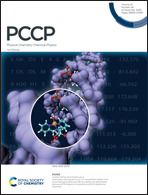Circular dichroism, anisotropy and absorption spectroscopy of chlorophyll b in methanol and mixed methanol–water solutions†
Abstract
The spectroscopic properties of chlorophyll (Chl) strongly depend on interactions with other Chl molecules, a fact that nature exploits in light harvesting by photosynthetic proteins. In solution, complex Chl aggregates are formed that depend not only on the solvent, but also on the detailed preparation procedure. Here we report synchrotron radiation circular dichroism (SRCD) spectra of Chlb in methanol (MeOH) and MeOH/H2O mixtures; in the latter, water molecules assist in the formation of Chl aggregates as Chlb is too hydrophobic to dissolve in water. The magnitude of the most prominent CD signal increases up to 100-fold over time (2–15 hours) when the water content is increased from 0 to 50% in volume, the signal is non-conservative (almost exclusively negative), and sensitive to sample preparation. Three different types of signature CD spectra (Types A to C) are identified depending on preparation, and the change in CD signal over time and with temperature is further analyzed with anisotropy spectroscopy (ratio of simultaneously recorded CD to absorption) and principal component analysis (PCA). We show that CD is clearly superior to pure absorption spectroscopy in identifying structural changes, and anisotropy spectroscopy further increases the sensitivity towards smaller structural changes. PCA on temperature dependent CD data show that depending on preparation, and thus the type of aggregate as revealed by the CD signature, either one (Type A) or two chiral species (Type B) are identified in the spectra, further evidencing the complex nature of Chlb aggregates. Furthermore, the CD signal decreases linearly with volume when a sample of Chlb in MeOH/H2O (i.e., a sample of Chlb aggregates) is diluted, which implies that the aggregation process is irreversible: once aggregates are formed, they largely do not revert back to monomers. However, anisotropy spectroscopy reveals that there are small changes in the aggregates, not directly noticeable in CD and absorption. The work presented here demonstrates, compared to absorption spectroscopy, a clear advantage of CD and anisotropy spectroscopy in studying the complex evolution of Chl samples with time and temperature.



 Please wait while we load your content...
Please wait while we load your content...